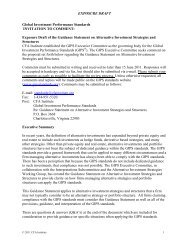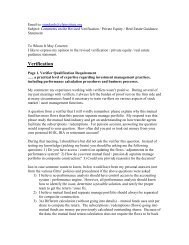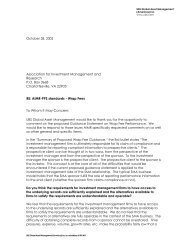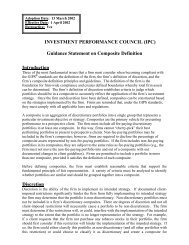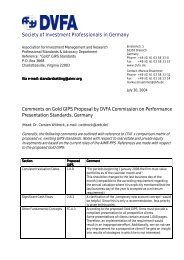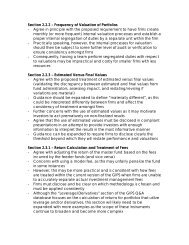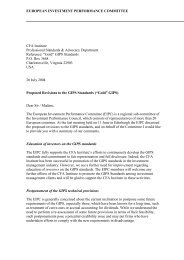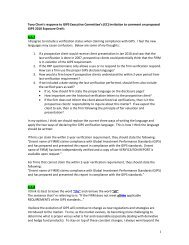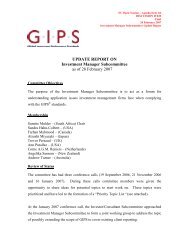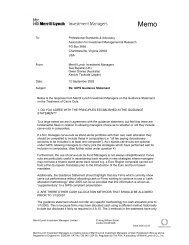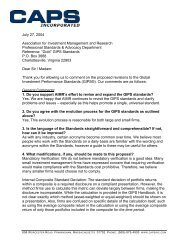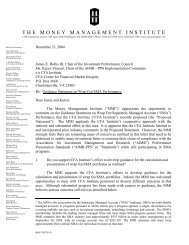Best Practices for Creating and Maintaining Policies and ... - GIPS
Best Practices for Creating and Maintaining Policies and ... - GIPS
Best Practices for Creating and Maintaining Policies and ... - GIPS
You also want an ePaper? Increase the reach of your titles
YUMPU automatically turns print PDFs into web optimized ePapers that Google loves.
Example policy:All per<strong>for</strong>mance results are total returns, including both realized <strong>and</strong> unrealized gains <strong>and</strong>losses plus income. Portfolio per<strong>for</strong>mance results are calculated on a monthly basis using theModified Dietz method. Sub-period calculations are per<strong>for</strong>med during periods where largecash flows occur. Sub-period returns are geometrically linked to arrive at monthly,quarterly, <strong>and</strong> annual returns. Cash flows are assumed to occur at the beginning of the day.Returns <strong>for</strong> cash <strong>and</strong> cash equivalents held in portfolios are included in all returncalculations. All returns are calculated after the deduction of actual trading expensesincurred during the period. When applicable, per<strong>for</strong>mance is calculated net of nonreclaimablewithholding taxes on income <strong>and</strong> capital gains.Procedures to consider:• The firm’s procedures related to portfolio return calculations should address the systemsused <strong>and</strong> whether the calculations are per<strong>for</strong>med internally or by an outside vendor. Notethat even if the firm has outsourced portfolio calculations, the firm is still responsible <strong>for</strong>the accuracy of the calculations <strong>and</strong> <strong>for</strong> ensuring adherence to the <strong>GIPS</strong> st<strong>and</strong>ards. If athird-party is engaged to per<strong>for</strong>m portfolio-level per<strong>for</strong>mance calculations, it is importantto review a sample of portfolios on a regular basis to verify the calculations.• Firms should consider establishing procedures to periodically compare portfolioper<strong>for</strong>mance to composite per<strong>for</strong>mance to assist in identifying outliers that could indicatevaluation, cash flow, or calculation issues.Helpful hints:• It may be helpful to include <strong>for</strong>mulas <strong>and</strong> definitions in the firm’s policies to explain themethodologies used, including indicating if any details have changed over time.• The firm’s policies should indicate how cash flows are treated (e.g., accounted <strong>for</strong> as ofthe beginning or end of day) <strong>and</strong> that a consistent methodology is applied.• <strong>Policies</strong> <strong>for</strong> converting returns into different currencies should also be outlined, ifapplicable.IX. Composite per<strong>for</strong>mance calculationsThe composite return is the asset-weighted average of the per<strong>for</strong>mance of all portfolios in thecomposite. Firms must document the methodologies used <strong>and</strong> the frequency <strong>for</strong> asset-weightingportfolio returns when calculating composite returns. Similar to the portfolio valuationrequirements, the <strong>GIPS</strong> st<strong>and</strong>ards have gradually increased the minimum required frequency <strong>for</strong>asset-weighting portfolio returns in order to calculate composite results. Quarterly composite<strong>Best</strong> <strong>Practices</strong> <strong>for</strong> <strong>Creating</strong> <strong>and</strong> <strong>Maintaining</strong> <strong>GIPS</strong> <strong>Policies</strong> & Procedures Page 16



